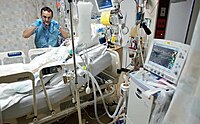
Photo from wikipedia
Objective Hyperglycemia is common in critically ill patients after surgery and is associated with worse perioperative outcomes. Yet, the impact of postoperative hyperglycemia on long-term outcomes remains unclear. We therefore… Click to show full abstract
Objective Hyperglycemia is common in critically ill patients after surgery and is associated with worse perioperative outcomes. Yet, the impact of postoperative hyperglycemia on long-term outcomes remains unclear. We therefore analyzed the association between early postoperative hyperglycemia and 3-year overall survival in older patients who were admitted to the intensive care unit after surgery. Methods This was a post hoc analysis of database obtained from a previous randomized trial and 3-year follow-up. The underlying trial enrolled 700 patients aged 65 years or older who were admitted to the intensive care unit after elective non-cardiac surgery. Early postoperative time-weighted average blood glucose was calculated and was divided into three levels, i.e., <8.0 mmol/L, from 8.0 to 10.0 mmol/L, and >10.0 mmol/L. The primary outcome was 3-year overall survival. The association between time-weighted average blood glucose level and 3-year overall survival was analyzed with Cox proportional hazard regression models. Subgroup analyses were also performed in patients with or without diabetes, and in patients following cancer or non-cancer surgery. Results A total of 677 patients (mean age 74 years, 60% male sex) were included in the final analysis. Within 3 years after surgery, deaths occurred in 22.1% (30/136) of patients with time-weighted average blood glucose <8.0 mmol/L, compared with 35.7% (81/227) of those from 8.0 to 10.0 mmol/L (unadjusted hazard ratio 1.75, 95% CI 1.15 to 2.67, P = 0.009), and 36.9% (116/314) of those >10.0 mmol/L (unadjusted hazard ratio 1.91, 95% CI 1.28 to 2.85, P = 0.002). After adjustment for confounding factors, the risk of 3-year mortality remained higher in patients with time-weighted average blood glucose from 8.0 to 10.0 mmol/L (adjusted hazard ratio 2.28, 95% CI 1.47 to 3.54, P < 0.001) and in those >10.0 mmol/L (adjusted hazard ratio 2.00, 95% CI 1.29 to 3.10, P = 0.002). Similar results were obtained in the subgroups of patients without diabetes and patients following cancer surgery. Conclusion For older patients admitted to the intensive care unit after elective non-cardiac surgery, high early blood glucose (time-weighted average blood glucose ≥ 8.0 mmol/L) was associated with poor 3-year overall survival. The impact of moderate glycemic control on long-term survival deserves further investigation.
Journal Title: Frontiers in Medicine
Year Published: 2022
Link to full text (if available)
Share on Social Media: Sign Up to like & get
recommendations!